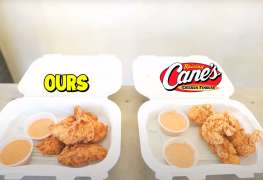 The short answer: about $50,000 on the low end, at least in California. The long answer: it can cost much, much more to actually get a food truck business off the ground — depending on who you are, where you are, and what your goals may be.
The short answer: about $50,000 on the low end, at least in California. The long answer: it can cost much, much more to actually get a food truck business off the ground — depending on who you are, where you are, and what your goals may be.Food trucks have been a source of growing interest for the food and restaurant industry, and for good reason. First-time entrepreneurs will find a much lower barrier of entry to the business starting a food truck than they would with a brick-and-mortar restaurant, since the costs are more affordable and you don’t need a strong business background. On the flip side, many successful restaurant groups are now looking at food trucks as opportunities to more successfully service their internal catering needs and serve as a marketing vehicle for their restaurants.
We talked to Matt Cohen, founder and CEO of Off the Grid, a network of gourmet mobile food trucks that hosts weekly markets at various locations throughout the Bay Area. Here are 12 things you need to get a food truck up and running, with Matt’s estimated price ranges for each (based on typical costs in the Bay Area).
1. Business Plan
Most people know they need a business plan to start a brick-and-mortar restaurant, but Matt recommends them for people starting food trucks, too. “Increasingly, the trucks that are entering the space are sophisticated people who have put together business plans,” he says. “They have an idea of how to market themselves, how to communicate to their customers, and what their core value is that they’re delivering. Oftentimes with a business plan some of those assumptions can end up needing to be changed on the fly, but the idea of building a business plan and being able to serve your needs is essential.”
2. Truck
As Matt tells us, each state has different requirements for what the construction standards are for a legal mobile food unit. “Generally, it’s a good idea to start with a manufacturer of food trucks that’s in your state to get a quote and an idea of what the expectations are for building standards,” he says. Then you can get quotes from builders outside your state to get a better understanding of what the competitive market might be.
All manufacturers will be familiar with the building codes required for a food truck to operate. When buying a truck, Matt recommends having your builder guarantee that the truck will pass code in the location where you’re going to be operating, or you get your money back.
The cost of a food truck varies wildly across the United States, but Matt says in the Bay Area an owner should expect to spend about $50,000 on the cheapest end. That figure can range all the way up to $200,000 for a “totally customized, pimped-out, brand new construction vehicle.”
And FYI: food trailers and carts are significantly less expensive, since you’re not buying the automobile. Matt estimates around $30,000-$50,000 to purchase a trailer (in California) and $20,000-$25,000 for a cart. In Portland, he says, a trailer may be anywhere from $10,000-$30,000.
Estimated Cost: $50,000 to $200,000
3. Commercial Kitchen
Needs vary from one mobile operation to another, but most modern food trucks operate out of a commercial kitchen, a shared space where they prepare and store food. When the truck is ready to go out and serve, they pick it up at the kitchen. Larger operations — or ones that plan to expand — should factor commercial kitchen rent into their startup costs. Having one makes it much easier to open a second truck and grow your business down the road.
Estimated Cost: $20 to $30 per person per hour
4. Truck Commissary
Similarly, you’ll need a secure place to park your vehicle. You need power to store your food overnight, fresh water, and you need to be able to fill your truck with propane. That’s where a truck commissary comes in. It’s another potential startup cost, if you have to pay rent on the space.
Some cities have truck commissaries and commercial kitchens in the same general area, but in other cities that infrastructure isn’t as well defined. As Matt explains, that’s how a truck owner/operator’s day can become very long.
“Say you need to arrive for a lunch service at 10; you’re going to serve at 11. Those vendors need half an hour of travel time — that’s 9:30. They need half an hour to 45 minutes to stock their vehicle at their kitchen commissary. You’re at 8:45. You need to drive from the truck commissary to the kitchen commissary, that’s another 20 minutes, say 8:30. You need to pick the vehicle up and do all the stocking at the commissary, that’s 8. You need to take into account all the food preparation, the purchasing of items — the day can start at 6 in the morning. That’s only for the first lunch shift.”
Add in dinner service, and Matt says it’s not uncommon for the day to start around 6 a.m. and finish at midnight. “What you’re making up for in a cheaper startup expense, you’re paying for in the labor and time to get from A and B.”
Estimated Cost: $500 to $1,500 per truck per month (depending on services available)
5. Health Permit
One of the first things you need to do as a food truck operator is get your health permit, which will determine where you’re legal to serve. That will, in turn, determine so much of your service: the location, hours, your audience, and other street food vendors you may partner with. Matt says that at Off the Grid his relationship with any vendor starts with them obtaining their health permit, because that will give him an idea of the options that are available to them and the openings he has in those areas.
Estimated Cost: $800 to $5,000 per permit
6. Route Plan
Food trucks are not guaranteed a place to park. “What you’re getting in a cheaper alternative to a restaurant, you’re also giving up in the consistency of having a roof over your head or a guaranteed parking space,” says Matt.
Map out a route plan where your vehicle can go and where you’ll be able to access an enthusiastic customer base — it may take some research, but you’ll save time in the long run sticking with tried-and-true locations.
7. Staff
There’s no hard and fast rule for how many people you need to run a food truck, but it all starts with one person: you. “The reason why a street food business was originally successful for entrepreneurs was because it could be owner operated for a long time and produce a pretty good living for its owner,” says Matt.
Really, your staffing needs all come down to the style of business you want to run. In environments like the Bay Area trucks may have four to six people working inside to accommodate the high volume of orders.
Estimated Cost: Differs by region, but about $15 per hour for line staff and $20-22 per hour for managers
8. Menu
Successful food trucks do a handful of things very well; you don’t need a 20-item menu. Matt explains: “In a restaurant, you have a long menu to serve the same community of people all the time in a particular neighborhood. The difference with a food truck is that their neighborhood moves around all the time with different services. The menus tend to be much more narrow and oriented towards specialty foods. It’s an opportunity to get known for a particular item.”
The sweet spot is around two to three core menu items, plus a dessert option and drinks. Those options may change over time, as you find out what resonates with the customer base. And keep in mind that customers are making decisions with their eyes, so it’s important to communicate clearly what’s being served, from the exterior of the vehicle to the menu. Regional specialties and artisanal offerings work well. “Street food is not a subtle business,” says Matt.
Matt also recommends cross-utilizing foods in a few different menu items for maximum efficiency. “There can be an element of customization, but you use your same marinated pork in your burrito that you use on top of the French fries, for example.”
Estimated Cost: Generally, 25-33% food cost
9. Audience
Plenty of cities are home to exciting street food scenes, and they each have their own specialities. Los Angeles is regarded for its loncheras, the traditional Hispanic food trucks. Portland has a successful food trailer culture, where it’s inexpensive to get started and the food offerings run the gamut. In New York, there’s a diverse number of food trucks and carts, including the halal vendors on city sidewalks. The Bay Area focuses on chef-driven menus, where people are attentive to local sourcing in the preparations of the food. Austin has a tremendous street food population as well, specializing in barbecue and Southern food.
10. Social Media & Marketing
Once you settle on the type of food you want to serve and find a route that supports it, you need to reach customers. One of the truly special things about food trucks is the face-to-face connection owners forge with their customer base, which establishes an identity for the business.
Social media marketing is an extension of that, says Matt. “Social media is an opportunity to amplify that personality in a particular direction — that’s why it’s been so effective for food trucks. And ultimately, food trucks are mobile. If you’re cruising around and there’s some uncertainty about when you’re going to be in a particular place at a particular time, social media allows you to give your customers confidence that you’re going to be there.”
Email marketing is another useful method for communicating with customers, just as it is for brick-and-mortar restaurants.
Estimated Cost: Anywhere from $50 to $50,000 for a website and marketing support
11. Network
Organizations like Off the Grid bring together multiple mobile food vendors in one location for a street food extravaganza that goes a long way in attracting customers. Participating in these events is a great way to reach more people. Once vendors get their health permit, they can apply to work with Off the Grid and will be considered for various opportunities that come up, based on their business goals and priorities (lunch service vs. dinner, ideal locations, etc.) Similar organizations exist in other metros, so do a little research to see what’s available to you.
12. Sense of Humor
Don’t take it too seriously — it’s just street food! “A sense of humor and sense of whimsy tends to be important with most food truck businesses,” says Matt. “Having and communicating a sense of humor is important — it helps you connect with your audience and customer base better.”








Leave a comment